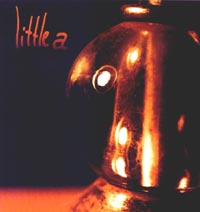Currently only excerpts & illustrations from the last 13 issues
(numbers 43 to 55) are on this site.
Scroll down to view the June 2001 issue. Click on the numbers to view other issues.
Info about the current book on the arts
|
 |  |
 A listing of the contents 1992 - 2002 >> (numbers 19 - 59)
A listing of the contents 1992 - 2002 >> (numbers 19 - 59) |
Contents List |
 |
excerpts & illustrations
(The full articles are only available in the printed magazine. Click on "subscribe" for more info.)
|
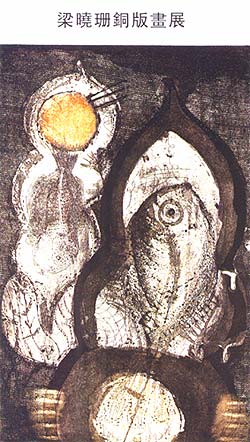 Etching Etching, 1995 by Liang Xiaoshan, P.R. China. |
number 55
June 2001
News & Letters
Praying for the Rain, music CDs Sanctuary is a recording of a benefit concert held in St Pauls’ Church, Hammersmith, U.K., in 1995 for two
HIV aid projects. Dominic and Vincenzo DeCicco are the driving force behind a collective of musicians exploring their roots through the tribal experience. Numerous acoustic and electronic instruments mingle and create counter rhythm to the vocals. Enchanted is a 1996 recording, again, incorporating numerious instruments and musical styles. In their evocative lyrics and atmospheric music the spiritual and the forces of nature are major themes.
For orders contact Twin Arrows Music, 510 Brixton Road, London, U.K., SW9 8EN
fax: 00 44 2072745519 or visit their website: www.dmlc.com/pftr
|
Illustrations / Images sought
Kalimat Press, an independent publisher of books on Bahá'í history, scholarship, community development, biographies, and deepening materials, is seeking images by Bahá'í artists which would be appropriate for use on book covers. Please send photographs of your artwork (color preferred) electronically as tif or jpeg files to: kalimatp@aol.com, or by regular mail to: Kalimat Press, 1600 Sawtelle Blvd., Ste. 310, Los Angeles, CA 90025, USA.
You will receive a response but publication is not guaranteed.
|
 Photograph by Gennagia Belyajev, Russia.
|
Letter from , French Guyana
I've been playing with our African drum group of 7 people since Istvan Dely, a Hungaro-Cuban trained resident of Colombia visited French Guyana and initiated some youth during a Pearls of the Caribbean teaching project.
A few full moons ago, we added the guitar for the first time. The lead drummer plays a wonderful African style guitar, and I brought my little amp so we could hear it above the drums. The Malian drummer's wife sang, we had about 4 djembés, a Djabara (shaker), a doundoun (big bass rhythm drum), a recorder, and some bells (pieces of iron that we "clang" for the rhythm).
And for the first time, I brought my whole family, my wife, my two daughters, a neighbour boy, and a girl in the DDW [Diversity Dance Workshop) dance group. My kids all have basic notions about drumming, and so while the "pros" practised, they accompanied. African music is very good in that way, it allows people to participate, dancing, singing, rhythmically and instrumentally. One daughter likes dancing, the other likes the rhythm. Our neighbours are Malian Moslems, very nice people, the DDW dance group had danced at their Tabaski festival. We hope that with our contacts of friendship and solidarity, we can invite the group to play for the opening of the Bahá'í Center in Cayenne.
|
Review:
pages 3 - 6
Review of two chapbooks of poetry
by
reviewed by
|
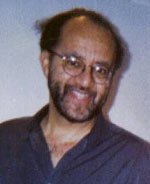 Anthony A. Lee |
"Art emerges from an intense valuation of the ordinary," writes Ashton Nichols in his The Poetics of Epiphany, a study of the poetry of William Wordsworth. It transmits "the
bread of experience into the radiant body of everliving life," the quotation concludes.
Two chapbooks, This is Going to be Short and Asia: The Lost Poems by Tony Lee transmit many slices of his experience: some radiant, some dark, some humorous, most quite simply told. "Poetry arrived in search of me," as Pablo Neruda put it in his lifelong statement of the function and purpose of poetry. That is partly how I would convey my recent reading of Lee's words...
|
He probes the mystery of his own experience and strives for a sense of its meaning. I am reminded of Eugene Ionesco's words: "the poet does not invent, he imagines.....in the imagination he carries along all sorts of symbols which are the profound truths of his soul."
Sometimes the truths, the events, are quite simple as in the poem 'First Kiss':
|
First Kiss
I chased her behind the house
and then behind the garage,
the little black girl with
short hair and pigtails all over.
I robbed a kiss while she squealed
and laughed at the game,
and then ran to my mother
to brag/confess my sin or victory.
Washing dishes, her hands
in the kitchen sink,
prim 50s curtains yellow over the windows
just before her face,
she looked up and stared ahead
not at me-
as if transported to a world of pain,
now long ago, now far away-
then suggested
with a frown
that I might find someone prettier. |
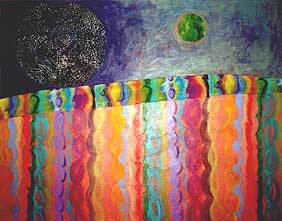 Celestial Bridge
Celestial Bridge, painting by Beth Yazhari, U.S.A.

At the Baha´i Centre of Asmara, Eritrea, 1995. Photograph by Hans J. Knospe, Germany |
...His poetry fits well into the tradition, now some forty years in the making, in its twentieth century dress, of confessional poetry. Lee hits you with his experience; it's straight from the shoulder. He's a good story-teller. You don't ask: is this true, correct, right? You bring to his poems what you bring to
life: as sane a mixture of judgement and dispassionate acceptance, as much as you can, as you possess.
Lee's poetry creates a telescopic lens which magnifies his experience and brings it as close as he can emotionally to his readers. In the process he avoids complexity, poetic archaisms and a whole panoply and pagaentry of poetic techniques. He gives you the everyday, the quotidian, the colloquial. There is a tendency to glamorize the self, but that is part of the game, the process, the exercise, that is confessional poetry. Going over the top is what readers experience in confessional poetry. It is what you get with the genre.
Poets try to move beyond the imprisoning ordinariness of the day-to-day. They try to move to higher purposes, to general principles. They try to get at their emotions and thoughts so often buried in life's hum-drum breathings, so often trapped under the weight of what existence throws up in their face, their lives. Let's look at the beginning and the final stanzas of Lee's eight stanza poem "The Road Not Taken" from his chapbook "This is Going to be Short".
|
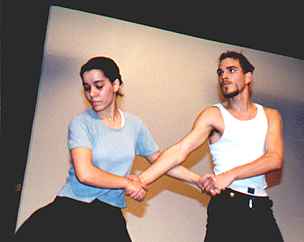 Equality Dance
Equality Dance, The German Bahá´í Dancegroup, 1996, photograph by Hans J. Knospe, Germany.
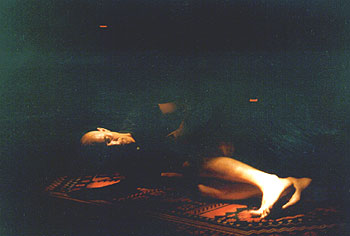
Dance/theatre piece by Roberto Lun
Austria, 1997. Photograph by Sonja van Kerkhoff,
The Netherlands.
|
I hitchhiked home from the Temple that night
some thirty years ago now
and this old, fat guy
who picked me up
told me I could have a job
that would take me around the world
if we could sleep together the whole time.
I stayed hip through the proposition, though,
I said it would be something new for me
(which was actually true at the time),
and I made him let me off at the corner
in Glencoe, Illinois.
.......
If he had been any younger,
or even had average looks,
I would have said yes,
Because I remember that night,
I was so tired of being alone
that suicide felt like a good thing,
even if it was the slow kind.
Anyway, I took another road
and ended up married, with children.
And there was no pool of blood
in the morning papers.
I learned to bleed slowly little by little,
without making a mess.
|
...This is confessional poetry at its best, at least for me. It's graphic, blatant, subtle, with a touch of wisdom and sophistication. Roger
White used to say, quoting Tagore, "the poem not the poet." In confessional poetry, poetry that focuses on the poet's experience, this aphorism could be reversed: "the poet not the poem." Perhaps the truth comes somewhere in between, differently for each of us according to our particular preferences, tastes and the kind of poem we are writing.
Lee's poems deal in contradictions and conflicts. Doubts, difficulties and dilemmas are part of his life--and ours. The next poem which I quote from caught my eye because I feel as if I might be ‘a real poet’ who ‘would never have to leave his garden.’ It is a psychological dilemma...
|
In the Garden
Someone told me that
a real poet
would never have to leave his garden
to find inspiration
for a lifetime of work.
My garden seems ordinary enough,
and I don't think it would be good for
more than two or three poems.
Everything is planted pretty much in place
Except over there
under the lemon tree...
|
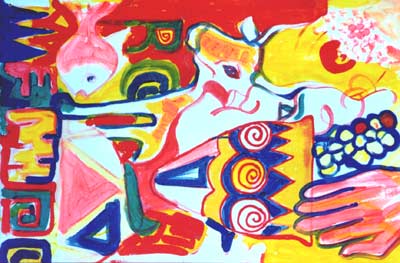 My Wealth My Wealth, 1999, acrylic on canvas.
by Philip Kwesiga, Uganda. |
The selection which follows comes from the same chapbook "This Is Going To Be Short." Of the two chapbooks Lee has published by High-Born Lady Press in Los Angeles in 1999, this is my favorite. It resonates with my experience; that's probably why. There are eight poems in this small booklet. Four of the poems, are written in three sections each, the rest of varying length each in one section. This is the last poem in the chapbook:
|
 Image to come by Filipe Tohi, Aotearoa / New Zealand.
|
First Glimpse
Yes, I remember the first time I saw her,
invited just for that
to that tiny beach house
in a crowd of thirty people of more.
She was smiles and laughter,
all gaiety and light--
the kind she switches on and off for strangers.
But I imagined the light switch on
and took the next step, calling and calling.
Calling again, until I was not longer strange.
|
Review:
pages 5 - 6
Miracles of Vision - Review of the exhibition
"Who Am I? Belief and Identity in Art"
at the Sarjeant Gallery, W-h-anganui, New Zealand, reviewed by Sonja van Kerkhoff, The Netherlands.
This is a show about belief, but it does not present belief as synonymous with the singular vision. The 12 themes spread in the 12 bays are not ‘Stations of the Cross’ - are not articulated as one story. The thematic areas are more like organic demarcations. Some assemblages are the results of workshops such as the workshop on devotion given by the Cuban visiting artist, Ana Flores. Here, an old hollowed out tree trunk, reminiscent of a pier or vessel, has been laid across two plinths. It is filled with what seem to be relics or offerings made by those in the workshop. A white cloth was pulled towards the ceiling from the middle of this like a covering for the precious cargo, or a sail. Offerings of ribbons, texts and papers were sewn into the cloth and piles of stones and sticks had been stacked in each corner of the bay. The vessel had a strong sculptural form, and on close inspection is also a receptacle for many small well-crafted evocative objects.
|
The way themes flow in and through the 12 arrangements is the strength of this densely packed show. The curator, Paul Rayner has managed to avoid stereotyping belief
- or identity, for that matter.
At the end of one wing McCahon's mystical work, "Venus and
Re-entry: The Bleeding Heart of Jesus is seen above Ahipara" is flanked on one side by the results of artist-in-residence Jeff Thomson's workshop on the self with high school students and on the other side by black and white photographs by Fiona Pardington and Laurence Aberhart. The McCahon is given hommage and rightly so. It glows and resonates, yet the adjacent works pull away from the iconic in subtle ways. |
|
 Overview of the exhibition "Who Am I? Belief and Identity in Art" Overview of the exhibition "Who Am I? Belief and Identity in Art", 2000 From the left: Black and White photographs by Fiona Pardington and Laurence Aberhart. The painting " Venus and Re-entry: The Bleeding Heart of Jesus is seen above Ahipara", by Colin McCahon is on the right. |
The self portraits by Thomson and others are raw and direct, physically pushing out into the spaces around. On the other side the Pardington photographs of found objects with religious and Maori associations raise questions about our colonial landscape of debris. The Aberhart photographs are closer to McCahon in sensibility but like the other works are intimately connected to the concrete world.
|
 "To the Glory of God" "To the Glory of God" photograph by Laurence Aberhart. |
In one photo the words, "To the Glory of God" seem to shout out of the stone they are embedded in while the majestic Mount Taranaki backdrop anchors the eye. With simplicity both tombstone and mountain are shown as markers in the land.
Next to the photographs, Matt Hunt's figurine arrangements on about 30 tiny shelves turns all this hommaging on its head. |
Small handwritten scripts tell of aliens, of takeover by a false prophet with 6 fingers. It is raw, colourful and funny.
Rayner's inspiration to develop the show began while interviewing the W-h-anganui abstract painter, Prakash Patel. He realised that belief informed Patel's secular-looking work. In this show Patel's abstract paintings are arranged around a rangoli altarpiece, next to a bay celebrating Catholicism. It could be tempting to present two such themes as examples of the ritualistic but this has not been done. |
The colourful Hindu altarpiece works as both counterpoint and compliment to the dark abstract paintings while the Ann Noble photographs of nuns document with sensitivity, the devotional and intimate. On the borderline between these two areas is another McCahon, the 1952,
"There is only one direction (Mary and Jesus)" of a monotone Madonna and child, flanked by the words of the title. The words at first glance point to a singular and certain vision. But the image is not a Christian statement of affirmation in the 'sacred art' tradition. |
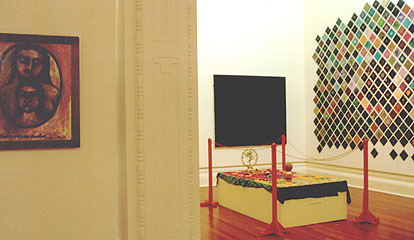
Left to Right: "There is only one direction (Mary and Jesus)", by Colin McCahon,
Hindu altarpiece and paintings by Prakash Patel. |
The Holy pair, and particularly the volumes of the child's face, are earthy. The child stares out, and I think, "This is MacCahon looking, telling us there is only one way forward." Does it mean all directions are really one? The figures are solid, directed. Perhaps the point is what might have been said, and is not., "there is only one way." "I am the direction, the truth and the life?" The destination makes the identity.
 Across from the McCahon, a huge teardrop shaped form by Marie Smuts-Kennedy hangs from the ceiling. Numerous hands emerge out of it, reminescent of those multi-handed deities. Next to this, a Pauline Thompson pastel of clouds in an estranged landscape. Across from the McCahon, a huge teardrop shaped form by Marie Smuts-Kennedy hangs from the ceiling. Numerous hands emerge out of it, reminescent of those multi-handed deities. Next to this, a Pauline Thompson pastel of clouds in an estranged landscape.
The McCahon is located on an intersection: the concept of a singular vision is one religious container alongside others....
...In another bay the words on a panel "No hea Koe?" reminded me that responding to the questions, Who Are You? Where are you from?
has many ramifications from a Maori viewpoint. A series of photos show the work of Ngati Mahuta/Upokorehe carver, Dean Flavin for his home whare whakairo (Tribal Meeting House on the East Coast of the North Island). The emphasis here was on community identity in a carving project spanning seven years...
|
Around the corner this theme flowed into works where letters and words dominate. Joanna Margaret Paul's "Frugal Pleasures" juxtaposed Latin text with still life watercoloured liquid forms.
The whiteness of the table cloth is her altar and her world and the fruits and words are both reminders of contemplative asceticism and layered reflexivity.
In Peter Ireland's painted samplers of the spirit, letters hover over darkened romantic landscapes.
|
 One of the Frugal Pleasures series, 2000 painting by Joanna Paul, New Zealand |
Further on Faith McManus has married letters to the clothes we wear. The garments, with their fold-over tags, are flattened by even colour. They assume a lively physicality when the imbedded words are recognized as a song taught in learning Maori, which immediately remind us of our postcolonial world. The clothing is made to fit over flat toys, and a suppressed language is relearnt. The vivid clothing is teaching us something too, about celebration and the mutability of appearance. The formalism in the adjacent Philip Trusttrum canvas garment-like cut-outs in "Button Down", seem to be given a context by the McManus works.

Left to Right: "Button Down" by Phillip Trusttrum and the silkscreen series by Faith McManus.
|
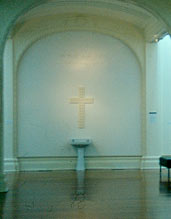  Finally, there is a huge crucifix form by Rebecca Pilcher. It is made out of 68 bars of virginal white soap and hangs above a porcelain sink. This could be an altar and yet is not an altar. The work is surrealist in its playful use of material and association. The soap could be like bits of a puzzle. We wash daily, perhaps we should pray daily? Is washing prayer? Or, does the cross dissolve, like soap? Yet this 'altarpiece' is an ordinary sink, so the cross looms over me as I mentally wash. On rising, my reflection is replaced and absorbed by the soft rounded forms. I see a cross or I see soap instead of the expected mirrored self. Finally, there is a huge crucifix form by Rebecca Pilcher. It is made out of 68 bars of virginal white soap and hangs above a porcelain sink. This could be an altar and yet is not an altar. The work is surrealist in its playful use of material and association. The soap could be like bits of a puzzle. We wash daily, perhaps we should pray daily? Is washing prayer? Or, does the cross dissolve, like soap? Yet this 'altarpiece' is an ordinary sink, so the cross looms over me as I mentally wash. On rising, my reflection is replaced and absorbed by the soft rounded forms. I see a cross or I see soap instead of the expected mirrored self.
It's a piece about the everyday after all, and yet … no day is just the everyday. There is only one direction then, from where we are to something more, to the transcendence immanent in the now. And tomorrow will be the same, but not as this is.
|
Review:
page 20
Ten Esperanto Poets in English translation
reviewed by Anneke Buys, The Netherlands.
...This selection gives a good impression of how subtle and rich Esperanto is now. Dr. Zamenhof, the initiator of Esperanto, (1859-1917), could use only a limited stock of words to express his ideas and feelings. His works, both original and of translations of world literature, shaped a tradition for others to build on.
The themes in this collection are universally recognisable: love, nature, art, growing older. William Auld's "La infana raso" is translated into a number of languages, Marjorie Boulton's "Faktoj kaj fantazioj" (Facts an fantasies) is loved by all beginners as it combines a gradually growing stock of wordswith wit and charm...
|
Artist Profile:
pages 6 - 9
Bruce Grover, rock singer / songwriter, U.S.A.
|
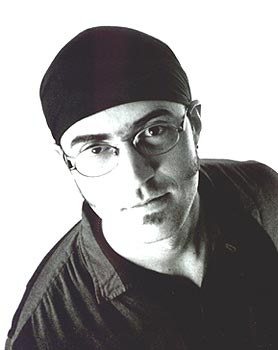
Bruce Grover. Photo: Liz Linder, U.S.A.
|
As a singer, I believe in singing what feels physically right, and by this I mean, how does the sound feel in my chest, throat and mouth? The music usually has a feeling to it that I write words and melodies to. For example, I love how velvety smooth a single held note can be with a lot of air in it. It feels amazing in my throat. And then chords change underneath that note, such as when I'm singing a 3rd or a 5th (something 'pretty' but basic), and I find myself suddenly singing a 9th or a flatted 13th (dissonant but beautiful).
The vibrations in my body are also added to by the sound of the guitar in the room. It's like throwing pebbles into a pond and watching their waves interact. There are times when notes feel like velvet in my throat and then turn to marbles that I roll around in my mouth and then become bubbles floating across the room. Other times for louder stuff that might have anger in it, the notes scream and are more violent physically. Because of technique, these spiky notes don't hurt me, but they do feel painful and very satisfying and cleansing... |
As a lyricist, I've always wanted economy. I feel that less is usually more. I want the words to not only carry melodies but for them to be almost chewable, so that you can feel them in your mouth and in the ‘mouth’ of of your brain. They have a distinct reason for being in a line, in a stanza and in a song.
I also want my lyrics to be a true story. All my songs are either about me or an experience I've had. That sounds a little obsessive but writing about personal stuff can be about other people, or about God, love, death or whatever. I've always been drawn to stuff that is personal to the writer. The words have to come from some deep place. Often I don't realize what my lyrics are about until some time has passed...
|
My band, little a, was formed six years ago by the guitarist David Kirkdorffer and me. We met through a drummer I had played with, and we clicked immediately. We wrote three songs in our first rehearsal. David wasn't ready to commit to another musical endeavor, so he started a recording project to get some of this new material out. I sang on the songs we'd written and local radio picked up on the song 'Jane'. We kept writing together, and eventually added a drummer and bass player. We've released two CDs and four singles and had exposure from college radio to national press. We played lots of shows to support these releases and had a wonderful and sometimes frustrating time doing it. We're wrapping up CD number three and are excited 'cause it's the best thing we've ever done.
Bahá'u'lláh says there is a power that comes from working in groups. little a has been very instructive in this way - letting go (or being forced to let go) of attachments for the betterment of each song and so forth.
|
|
The guitar player comes from more of an older rock place (King Crimson et al) and I come from more of a punk and folk place (The Clash, U2, Ani Di Franco, Radiohead et al). Our drummer comes from a Metal/groove background. Yet the music transcends our backgrounds and comes from the best part of each of us - the power of unity and reflection...
|
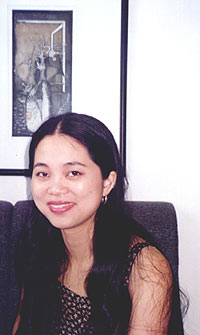
2001. Photo: Wendy van Overmeeren, The Netherlands.
Behind her is one of her etchings.
|
Interviewed and translated from Chinese
by Wendy van Overmeeren, The Netherlands.
Liang Xiaoshan makes copperplate etchings using motifs such as fishforms, dust, ink and candlewax to express various visual patterns and atmospheric tones.
She graduated from the printing department of the Guangzhou Institute of Art in 1992 and graduated as an Assistant for the College Faculty Class from China's National Institute of Art in Beijing in 1995. Her works have been exhibited in galleries in Guangdong and Beijing and are part of collections of art lovers all over the world.
I had never thought that I would be able to make art. I think art is taking something very beautiful from simple everyday life - like digging into the earth for a piece of gold. I believe that everyone is an artist. In their heart each person can discover the beauty reflected in all creation. Some people see it but do not express it and some people see it and feel a strong urge to express it...
|
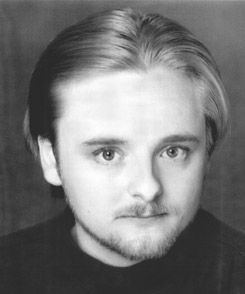 Alí Allié |
I got into film when I was twelve years old. My best friend had an 8mm film camera and we started with stop motion animation using clay and toys. We shot all kinds of stuff and learned the art of patience! Later on in high school I started using video when camcorders came out...
...Of course, you have to copy when you first start out. But it is the mature filmmaker who goes beyond that stage and imagines the destiny of one's images. If you imagine that the image you just created will be copied and sent to 100 people that you most respect, you ask yourself whether you would be proud of it or not. I'm not talking about fellow filmmakers, I'm talking about anyone in the world who has a solemn design for change - people like Nelson Mandela or 'Abdu'l-Bahá. |
...The irony is that in order to get to a high standard, we have to cast away expectations. A major challenge is the internal process of sometimes having to take an opposite course to end up where you think you want to get. The only way to do this is to have faith that your spontaneity can and should go in all directions (at once), and to forget about the work being good. By traveling down as many (simultaneous) paths as you can, you eventually and assuredly discover something you didn't contrive and whose purpose does not stem from the work being something you "should" do, but rather something that is refreshing. Then you know that you have it. And it can be very, very simple.
... |
A two-minute work can have a lot of impact. I did a one-minute film called Oración / Prayer that was about a Mexican woman praying. That film was shot on a single 100 foot roll of 16mm film (about three minutes of film) as an exercise to see what I could do knowing that I was limited to that. The piece showed at a Bahá'í Youth Conference in Phoenix. It is very fulfilling to do a small piece that has a lot of meaning. I think a better way to look at film is to look at it in smaller pieces. Sometimes when we don't think of the film as a collection of scenes, it becomes a sort of dinosaur we're trying to drag by the tail, instead of a series of small films that have a common thread....
One of the reasons I made El Espíritu de mi Mamá / Spirit of my Mother (my most recent film) was to reverently pay attention to my inner creative voices... |
 Still from El Espíritu de mi Mamá
(Spirit of my Mother), a feature film in Spanish with English subtitles. |
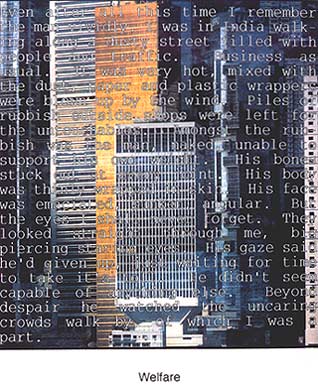 These two images are displayed side by side in the work, Polaroids
by Richard Paton, 1998
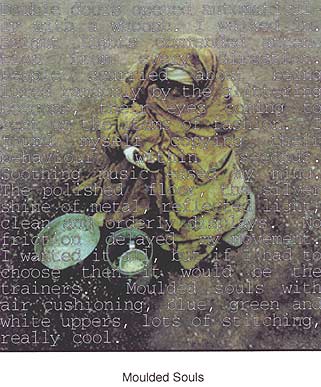 |
...A good film study article to read is Ray Carney's The Path of the Artist . He says "real art is not about yanking the viewer around, playing with expectations, or showing how ingenious you are, but reverentially exploring something you don't understand."
Many times we confuse cleverness with true innovation. And cleverness is surely the most valued quality in American cinema. It is important to ask ourselves, is that all we can do? Films that play with expectations can be very enjoyable. However, we must ask whether the film leaves us appreciating what the film is saying or more admiring how the filmmaker is saying it, and which is more important?
I don't believe art should imitate life necessarily. I believe that putting something on film is more important than doing something in life -- to me it has a greater significance.
Just the process of filmmaking itself testifies to this. The fact that we might film the same scene ten times is evidence that we are willing to expend a greater number of real, living moments in order to capture a fraction of them on a piece of film.
I'm not completely convinced that violence in film is directly related to people committing violence in life (in other words learning from films), but since I see film as better, greater and higher than life, perhaps more films should be libraries of the high points in humanity's spiritual journey and existence. 'Abdu'l-Bahá wrote in The Reality of Man that the difference between humans and animals is that humanity is capable of a spiritual life. Humanity is capable of overcoming the animal instincts, therefore not doing so is to forfeit our humanness. I believe film has the power to strengthen our humanness...
... El Espíritu de mi Mamá (Spirit of my Mother), touches on themes about the everlasting life of the soul and the idea that we are only temporary travelers on this earth...
|
The plot follows Sonia, a young Garífuna woman, who leads a troubled life as a houseworker in Los Angeles and is plagued by a haunting memory of a relationship with an American soldier. Her efforts to escape her present circumstances and past trauma are fruitless until she has a dream of her deceased mother who calls upon her with a sacred request. Sonia discovers she must journey back to the North Coast of Honduras to comply with her mother's request, at the same time leaving behind her old self. She learns from elders in her homeland what she must perform in honor of her mother so that she may rest in peace. The result is much more than that, as Sonia discovers her cultural roots and her own identity as a mother, stimulated by Garífuna ritual.
...The film isn't a documentary; it's no one's story in particular. Even though it deals with a very small cultural group, the themes are universal. In making the film, I sought to contrast the perception of life between the material realm of the United States and a natural and spiritually tangible world in Honduras.
The film begins dramatically in the United States where outsiders to the culture must ‘act’ to adapt. However, the dramatic style of the first half recedes as life becomes more real to the main character during her journey back to Honduras. Thus, the film begins to take on a more observational mode in order to allow a participatory experience in the Garífuna rituals, yet in the end returning to a dramatic and reflective characterization... |
Artist Profile:
pages 16 - 17
Line Clément,
performance, visual artist, France.
|

Ranger les couteaux et voir dormir le sable (Put away the knives and watch the sand sleeping), performance by Line Clément in the L'embarcadère Gallery, Lyon, 1993.
|
Line Clément makes installations, performances, prints and paintings often combining all media into one exhibition or event. Themes such as alchemy, magic, the spiritual and the natural world are often connected with urban related social issues.
She is a co-founder of studio Alma, an etching workshop in Lyon.
Art without the dimension of magic and the sacred, for me, is of no interest.
My aim is to find the 'active zone' within a work of art that links to our human destiny.
|
For me art must be a means of liberation and protection - like a talisman. My paintings are made in the spirit of and are intended to function as talismans. Whether art is temporary (performance work) or permanent (such as paintings or sculpture), it should create an 'aesthetic shock' - it should have a deep affect for a long time. It should have the strength to restore -to cure and to quicken the soul. Art needs two conditions to work. First an ethical committment on the part of the artist involving no manipulation of the public and second, to avoid imitation. Because art is about breaking away from the expected or from imitation it requires openness on the part of the public.
My performance work is prepared beforehand but a never repeated so that it is never pure improvisation nor rehearsed theatre. Their purpose is to create a sense of catharsis, a means of expression, (an aesthetic scream) as well as a means of self purification. I will describe one performance in detail.
|
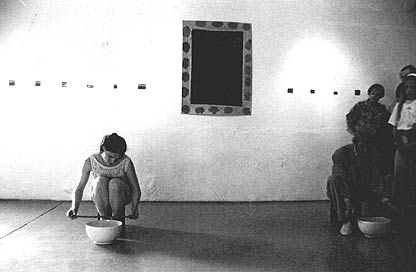 Ranger les couteaux et voir dormir le sable Ranger les couteaux et voir dormir le sable (Put away the knives and watch the sand sleeping), performance by Line Clément
in the L'embarcadère Gallery, Lyon, 1993. | The performance, Ranger les couteaux et voir dormir le sable (Put away the knives and watch the sand sleeping), was a response to the systematic rape of Moslem women in the Yugoslavian war.
It began with an alarm going off in the middle of where the public were gathered while I walked into a central space dressed in green army trousers and red anorak (padded jacket) with the hood pulled over my head... |
 Arkadij Bourkhanov Arkadij Bourkhanov, 2001.
Photo: Sonja van Kerkhoff, The Netherlands. |
During the 70 years of communism, all Western European musical styles were discouraged, and sometimes it was dangerous to play such music. There was a saying: "Today you play jazz and tomorrow you will sell our country". Even studying classical guitar was considered too western.
I studied classical guitar for five years during my years at school in Novosibirsk -the only music conservatorium east of the Ural mountains (covering an expansive part of Russia). Then I studied classical guitar and conducting for almost six years at the music school in Moscow. |
...During this time, I became interested in music for the lute and the recorder and spent two years serving in the military ensemble as part of my military service. I returned to my home city, Novosibirsk, to graduate in my studies at the conservatory in the six-string classical guitar and the lute. It was the first time that someone in Russia had graduated in the lute and for a first in my academy for the guitar.
I taught myself how to play them, with the help of the professor of the balalaika. After I graduated, I developed a course in classical guitar at the conservatory and still teach it today. After this I spent three summers studying guitar in the academy of arts in Prague. I started playing lute more and then finally stopped playing the guitar altogether. It isn't possible to play both instruments professionally at the same time; for example, for the classical guitar you need long fingernails while for the lute you need short nails.
...During these years of serving on the Bahá'í local and national administration, I was looking for a way to serve as a musician in a way that I felt comfortable as a professional musician. Some Bahá'ís had said that my music was not Bahá´í because there were no Bahá´í texts in it and because it was music from the past. I was told that the Bahá'í Faith was a new religion and so forth. Of course, no one said directly that my music was wrong, but I could feel the disappointment from Bahá'ís around me. And activities that used the arts to promote the Faith we had in Russia, such as the Zipopo (Institute for Positive Behaviour) talkshow and the Bahá'í Youth Dance Work-shops, were not my way of using the arts. |
 Insula Magica Insula Magica, performing during their Echo of Poltava tour, 2000. Read the review of Barca de Venetia per Padova by
Elena Frolova in the October 2000 issue of Arts Dialogue |
...For me, culture is a collection of spiritual and physical values, with a means for expressing it, methods for preserving it and ways to spread it. The foundation is primarily for social and economic development. I don't worry about whether it is a ‘Bahá'í’ project or not because I am a Bahá'í and my values are encompassed in Bahá'í values.
...One project that is now part of the Ark Foundation's activities is art education for children. We started with one high school in Novosibirsk, where my wife Elena teaches. Each child studies some aspect of the arts, which involves learning about other cultures.
|
The government supports this project but gives little financial backing, so money is collected from parents and we use donations of instruments, equipment and so on to support the program. The project has been going for 19 years now and has been so successful that many pupils have moved directly into professional arts studies....
Another project has been to create a mobile museum of the history of music. I know of only two museums of music in Russia and these are in Moscow and St. Petersburg. So people from Siberia need to travel at least 3000 km to see them. In 2001 travelled to Holland to buy a harpsichord to add to the collection. It was the first authentic harpsichord in Siberia.
My musical ensemble, ‘Insula Magica’ (Magic Island), is the basis for the museum, and it performs as part of the display. |
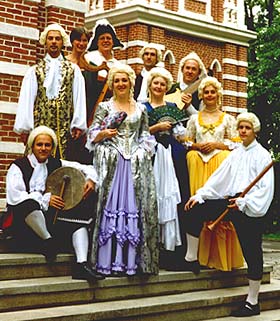 Insula Magica
Insula Magica, 2001. |
The group started performing twenty years ago with students from the conservatory. The name of the group came out of a time when there was not a lot of music around, so we saw ourselves as an island of magic from a previous time. After peristroika, artists and musicians lost the little government funding there was and so we have always had to find our own funding to pay for instruments and costumes.
Currently there are four singers and three instrumentalists; some of the singers also play instruments. We play everything from medieval to Baroque. In March 2001, Insula Magica will celebrate its 10th anniversary of professional performance for the Novosibirsk Philharmonic Society, with a festival of early music. For more information, see www.nut.adm.nso.ru/culture.
|
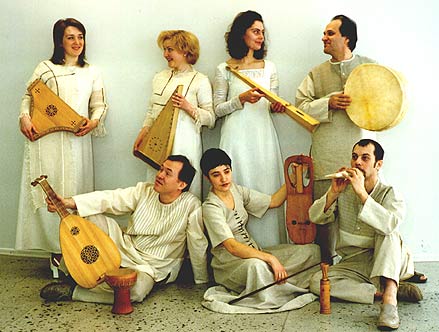 Insula Magica Insula Magica, 2001. |
...It is said that Peter the Great cut a window into Europe, which is why we chose the title Window into Europe for our first CD...
...we have just released a new CD Renaissance Music. Please contact me if you are interested in collaborating with or supporting our projects in anyway.
Email for The Ark Foundation for Cultural Initiatives:
Arkadij Bourkhanov,
ark[at]mail.cis.ru |
Poem
page 20
The Seven martyrs of Yazd
In memory of seven Bahá'ís who were executed in Yazd, Iran, in 1980.
I close my eyes, but to God to all
The seas have sunken, seven of them all.
But look, glorious gems,
have come out with style.
With one eye I weep
with the other I smile.
They were seven seas
of love and strength,
who sank to birng
gems of peace and
oneness
to the surface
of the earth.
|
 Watercolour (Cat) watercolour on paper,
Watercolour (Cat) watercolour on paper,
Bonnie Fields, U.S.A.
|
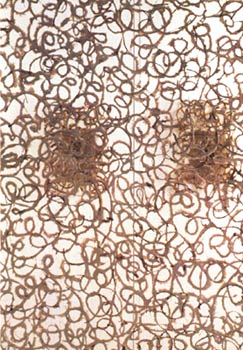 Nevernefer Nevernefer, 1998, hand-made paper. Leenakaisu Hattunen, Finland.
 IMAge to COME - Red Meteor, acrylic on canvas by Audrey Marcus, U.S.A. |
|
Poem
page 20
Excerpts from...
Lines for a Widower
In January 1982 six members of a Bahá'í administrative body in Iran, together with the hostess in whose home they met, were seized and killed for refusing to recant their faith. The husband of the hostess choice to deny his belief and was spared.
The reticent saints say nothing of apostasy
so let us turn to you. Were you widowed
by your cowardice or did sanity grip you in its
cool fever, moistening your blistered palms
to ease release from the burning cord of covenants?
We cannot guess what tremors stormed your ribcage
when the raging men swept through your home
to seize its brightest ornament.
her small white knuckles knotted with conviction
as she strode out to meet the harsh divorce of bullets....
...Do your children acknowledge as mother
your cold-eyed concubine, remorse,
who lays by your side wakefully
through the slow dark hours
listening to your heartbeat and
fingering her slender knife?
How shall we testify?
Give us your answers, quickly. Quickly!
Angry hands are beating on our door.
Roger White, 1982, Israel.
Excerpts from My Calamity is My Providence,
an anthology of poetry in response to the perscution of Bahá'í’s in Iran,
compiled by Tahirih Khodadoust Foroughi, 1984.
|
3 languages
White horse between sheep with
Lambs - something like
Small, Large and Extra Large
in animal fashion
|
3 lingvoj
blankaj chevalo, shafoj kaj
shafidetoj - io kiel
Malgranda, Granda kaj Ekstre Granda
en besta modo
|
3 talen
Wit paard tussen schapen met
lammeren - zoiets als
Small, Large en Extra Large
in animale mode |
by Anneke Buys, The Netherlands.
change of plan
I’ve often thought
if death were to sever me
from love,
I’d find it again
in brief time.
How arrogant of me
to imagine myself
love’s survivor,
that I would have
unlimited chances.
Every day, we speak
as though
days are too numerous
when in fact
there are too few.
If I do not see
the godly within you
I’m blind to God.
This seems to apply
equally to all.
Days might disappear
but for love.
I’ll fly to the sun
but you’ll remain alone
because you doubted mine.
by Cheryl Cudmore, Canada
|
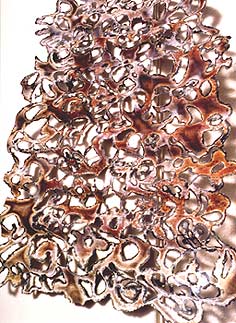 Lace Lace, perforated corrugated iron, 2000. by Jeff Thomson, New Zealand.
"While collecting perforated metal such as wire netting from rubbish tips, I realised that I could make my own perforations in the metal by using oxy/acetylene and plasma cutting (which gives a very fine clean cut). I liked the way the physicality of the material was transformed physically and psychologically. The metal looks lace-like and is no longer weatherproofing material."
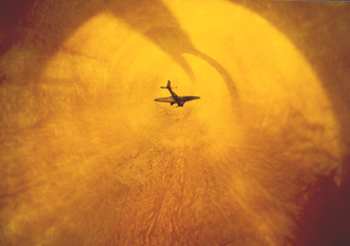 Hommage to Joseph Beuys Hommage to Joseph Beuys, Object-Painting, a toy airplane inside a lit cone-form, 1989, by Jessy Rahman, The Netherlands. |
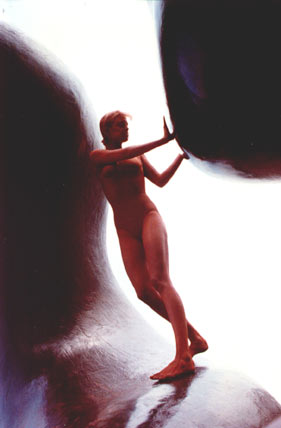 Armeephelan dancer in bronze Armeephelan dancer in bronze (between sculpture by Henry Moore), 1999,
Photograph by Mark Sadan,U.S.A. |
Morning thoughts
So much I could say, about dreaming with eyes open,
and how different it is when they are closed,
About the silence that falls as I walk through the forest,
and what my heart is murmuring to the sea.
About the fragments that comprise my life:
when day breaks, they are no more than memories.
About the way my heart makes little jumps in unguarded moments,
and how the night comes down.
Of how different things would be, if I said more, or said less
if words themselves were to stir, find the path from heart to heart,
and burrow down and disappear
and re-emerged, transformed, tomorrow.
And quite simply, about staring into space,
finding strength,
and realizing that today I may meet not only this, but also you.
by Eline Hermans, The Netherlands. |
The Storm
A spray of red carnations on the sill.
A fire framed in limestone waxes
in my semi-detached living room.
The habitual inventory of my men,
who is running for shore
who safe on what island, completes me.
I am waiting for the storm
and all the boats are in.
For two days I have bowstringed.
A humming deep in the ocean
vibrates me like a high tuned violin.
Every muscle, drawn like wire, sizzles
The wind rises. Locked in woodlands
I hear it tuning ash and oak
as i am hauled to where the sea
is shaping new mountains. At midnight
mad airs howl like wolves
and all the trees are bending.
Swaddle in the harbour of my bed
I am rocked on seethng water
absorbed in a green dance
that devours quays and laughts
at storm walls. I am a breaker
replacing beaches with boulders.
I fling wrack on a curved canvas
of ruined shore and fish drown
in my fury. The music crescendos,
ebbs, I sleep. Deep, deep, dreamless.
At evening I survey my redrawn beaches
satisfying new sand with footsteps.
The wanting moon hushes me home
where I am needed and Handel
is flowing from the radio.
by Mary O'Malley, Ireland.
From Where the Rocks Float, 1993,
Salmon Publishing, Dublin, Ireland.
|
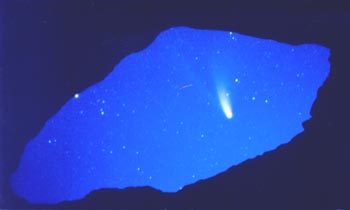 Hale Bopp Comet
Hale Bopp Comet, photograph by William Muñoz, U.S.A.
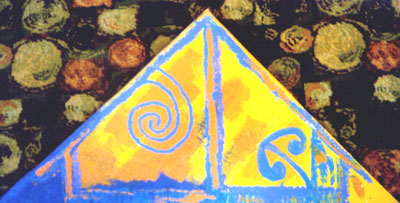 Triangular painting Triangular painting, by
Carwyn Ponga, Aotearoa / New Zealand.
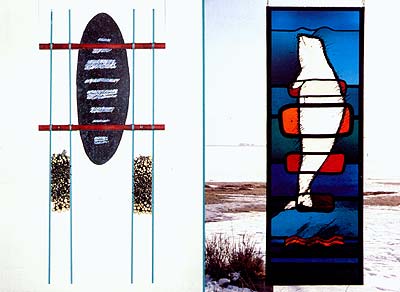 Kivirumpu I
Kivirumpu I, glass installation, 1991 by Mary Gregory, Finland.
|
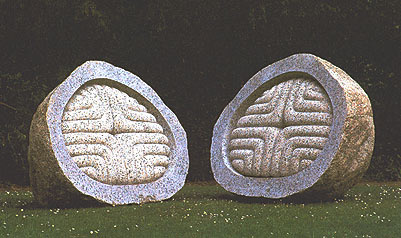 Secret Life II
Secret Life II, 1994, by
Peter Randall-Page, U.K. |
Fixeless Symmetry
Like the instant beauty
Of the crystal flake,
My soul quaked
At the din of time;
And, leveling in their flight
The shadows of evening,
I saw the void of air
Swirl into a mirror of ice,
More carved in the blast of the stone
Than all the summer’s tempests.
by Robert Schwarz, U.S.A.
|
Close Encounter
I have no quarrel
with any other aliens.
Flying this earth
in a saucer smaller
than myself,
I've passed
around the full moon and back,
thriving on light
and taking prisoners
from childhood. In praise
of the heavens without end
or beginning, I stand for you
as naked as a jaybird.
by Cal Rollins, U.S.A.
from the collection of poems, MALE RAIN, which can be ordered for $14 from:
Kalimat Press, U.S.A.
|
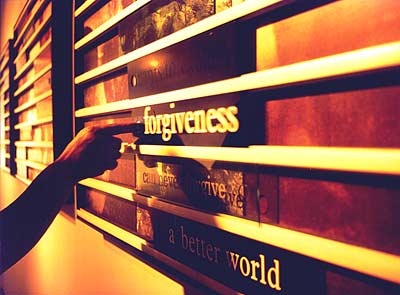 Truth Games
Truth Games, 1998, - a series of interactive pieces around the hearing of the Truth and Reconciliation Commission of South Africa, by
Sue Williamson, South Africa. |
A Sonnet
Your song and witness over there
For finding should some seeker dare
Recall that crux of circumstance
Making your rhyme strike true; your glance
Out-face hypocrisy, discomforting
Passed age’s sober parroting.
Or else
Some bright girl’s raven hair -
Or brown or blonde -, hot lips that dare
Give Eden’s passion sacred bent,
Though years with churchyard-mould be blent
Still catch the evening sunlight’s ray,
Still dare tomorrow for today;
If read
In small brown-paper book
Discovered by his passing look
Who’ll turn out trunks in some old loft
When snow stops work upon the croft.
Your resurrection so, in lives of others
Gives hope fresh meaning with your later brothers.
by Hugh McKinley, U.K.
|
Golden Alchemy
Crucibles of pain
transmute
the clay
into purst gold.
The fire cries:
"Change, change;
Melt the imperfection,
Vaporize the mist.
Luster gleaming
shall
be thy reward."
Searing soul experience:
I’m dying...
I’m...
Gone.
The pieces don’t remain.
They now BE
something new:
Newly created ones
who speak
new words,
new forms,
new vision.
A new song
fills new hearts
with new worlds.
by Duanne Herrmann, U.S.A. |
Photographs and Illustrations of work by:
Gennagia Belyeva, Russia, Hans J. Knospe, Germany, Bonnie Fields, U.S.A.,
Kaziek Wieckowski, Poland,
Sue Williamson, South Africa, Peter Randall-Page, U.K., Leenakaisu Hattunen, Finland, Richard Paton, U.K.,
Jeff Thomson, New Zealand, Mary Jane Gregory, Finland,
Philip Kwesiga, Uganda, Carwyn Ponga, New Zealand,
Linda Adams, U.S.A., Joanna Margaret Paul, New Zealand,
Jessy Rahman, The Netherlands, Audrey Marcus, U.S.A.,
Jacqueline Wassen, The Netherlands, Roberto Lun, Italy,
Keith Brown, U.K., Liang Xiaoshan, China, Helena Junttila, Finland, Filipe Tohi, New Zealand, Liz Linder, U.S.A., Beth Yazhari, U.S.A., Joke Elzinga, The Netherlands, Mark Sadan, U.S.A.,
William Muñoz, U.S.A., Line Clément, France.
Translations, editing, co-ordination, by:
Wendy van Overmeeren, The Netherlands / P.R. China,
Kathleen Babb, Japan, Alison Marshall, New Zealand,
Steve Marshall, New Zealand,
Sonja van Kerkhoff, The Netherlands.
|

Arts Dialogue, Dintel 20, NL 7333 MC, Apeldoorn, The Netherlands
http://Bahá´í-library.org/bafa email: bafa@bahai-library.com |
|

















































 Dance/theatre piece by Roberto Lun
Dance/theatre piece by Roberto Lun









 Insula Magica, 2001.
Insula Magica, 2001.
 Watercolour (Cat) watercolour on paper,
Watercolour (Cat) watercolour on paper, 











 Across from the McCahon, a huge teardrop shaped form by Marie Smuts-Kennedy hangs from the ceiling. Numerous hands emerge out of it, reminescent of those multi-handed deities. Next to this, a Pauline Thompson pastel of clouds in an estranged landscape.
Across from the McCahon, a huge teardrop shaped form by Marie Smuts-Kennedy hangs from the ceiling. Numerous hands emerge out of it, reminescent of those multi-handed deities. Next to this, a Pauline Thompson pastel of clouds in an estranged landscape.



